Home :: Products & Services
:: Hardware:: PMC High-Density VoP Network/Telephony Cards
:: SigC5441-SAR-PTMC
SigC5441-SAR-PTMC High-Density VoP/DSP Resource Card
This board is obsolete, and is replaced by
the SigC641x-PTMC and
SigC5561-7x7-PTMC boards.
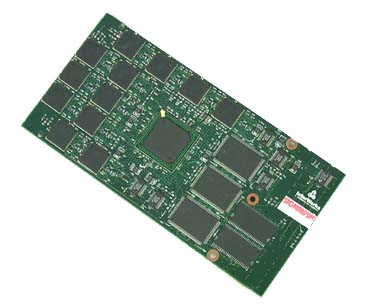 |
|
SigC5441-SAR-PTMC card shown above. The card contains up to (24) quad-core DSPs, packet processing SAR, PCI bridge logic, and TDM and network interfaces.
|
| |
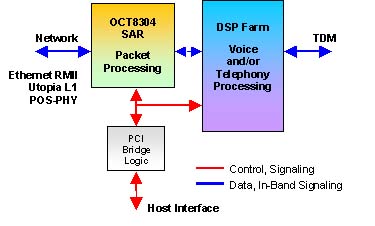
|
|
SigC5441-SAR-PTMC card data flow overview shown above; see data sheet
for detailed dataflow diagram |
| |
Overview
The SigC5441-SAR-PTMC card contains DSP resources, packet aggregation, processing and routing functions, and TDM and network interfaces in a compact PMC form-factor. The card provides a scalable high-density solution for next generation VoIP and VoATM infrastructure and carrier class products and equipment, particularly where low cost and less space are required.
In a typical VoIP or VoATM application, the SigC5441-SAR-PTMC processes TDM channels of 64 kbps PCM (G.711) voice, fax, or data traffic. Voice data is optionally compressed by Telogy DSP software via G.726 (ADPCM) or LBR codec. Either the Telogy software and/or the OCT8304 SAR provides RTP, RTCP, or T.38 packetization of voice and fax data. If network interfaces are required, the OCT8304 provides packet formatting, segmentation, reassemly, and routing functions. Network packet formats supported by the OCT8304 include VoIP (UDP/IP) or VoATM (AAL2 or AAL5).
Telogy DSP software additionally provides a wide range of VoIP, telephony, and data functions.
On the TDM side, the SigC5441-SAR-PTMC supports 10 full-duplex streams of 8.192 MHz each via its PTMC v2.15 interface, allowing connection to industry standard TDM busses such as H.110, H.100, and MVIP, ST-BUS, and SCSA.
On the network side, the card offers either Ethernet RMII or ATM interfaces (UTOPIA L1 or POS), also v2.15 PTMC compatible.
The 32-bit local PCI bus interface allows control of the board from Linux or other system software residing on the carrier board, supporting a wide range of telephony and protocol software options including MGCP, Megaco, SIP, or H.323 software stacks.
SigC5441-SAR-PTMC Feature Summary
VoP (Voice-over-Packet) PTMC card compliant with Telogy® voice software PTMC Configurations 2 and 3 compatible card, adhering to PMC mechanical and electrical specifications Highly scalable channel capacity - cost effective at channel capacities from 192 to 3200 TDM-to-TDM and TDM-to-Network data flow paths supported Network interfaces include UTOPIA Level 1, POS, and Ethernet RMII Network packet formats include VoIP, VoATM (AAL2 or AAL5) Up to 3200 channels of G.711 (PCM), up to 960 channels of G.726 (ADPCM), and up to 576 channels of LBR codec (G.729AB, G.723, or combination of other LBR) Up to 1152 channels of G.168 echo cancellation in combination with PCM, ADPCM, or LBR codec, up to 3072 channels of echo cancellation with no codec 10 full-duplex TDM streams on H.110 bus subset at 8.192 MHz each (2560 total time-slots) Local PCI bus interface provides access to onboard logic, SAR, and DSP resources Very low-cost "telephony only" and "DSP resource" configurations are available Supported by
VDS™,
DirectDSP®,
Hypersignal® development tools, and SigMGSS-cPCI carrier card platform. Onboard JTAG 1149.1 debug header with access to DSP JTAG chain, fully compatible with Texas Instruments Code Composer Studio software
Applications
Applications for the SigC5441-SAR-PTMC card include media gateways and media servers, base-station processing, VoIP (voice-over Internet protocol) networking functions, VoDSL (voice-over DSL), soft-switches, SIP Nodes, and multiple-channel speech or audio CODEC arrays. Some specific product examples include:
Telogy® Software Compliance
Below is an overview of software capabilities of the SigC5441-SAR-PTMC card when running Telogy voice software. For detailed information, see Software Specifications section below.
Voice Compression, G.711 64 kbps, ITU G.7xx LBR codecs, and GSM (see Software Specifications below) Echo Cancellation, G.165 and G.168, up to 128 msec Jitter Buffer Silence Suppression, Telogy VAD and CNG, G.7xx, GSM Fax Relay/Protocol Modern Relay/Protocol ISDN VoIP Standards Compliance, RTP, RTCP per RFC 1889/1890/2508 VoATM Standards Compliance, AAL0 (raw cell), AAL1, AAL2 I.366.2 In-Band Signaling / Call Processing, DTMF, MF R1, MF R2, MFC, SS7 COT, SF, Call Progress
Packet Processing and Aggregation
An Octasic 8304 SAR provides packet aggregation and processing functions, including VoIP (UDP/IP), VoATM (AAL2 or AAL5), RTP and CPS packetization, IPv4 and IPv6 support, and AAL5 support, including basic IP, LANE (V1/V2), and MPOA.
TDM Interfaces
Up to 10 full-duplex TDM streams are available from the PTMC interface, and may be distributed to onboard logic, TDM interface to the SAR, and/or among 12 full-duplex streams to the DSP farm. Routing to one or more destinations on the board is under software control.
All TDM interfaces are available on PN3 connector, according to the PTMC v2.15 specification, Configs 2 and 3).
Network / Packet Interface
The SigC5441-SAR-PTMC card offers Ethernet RMII, UTOPIA Level 1, and POS PHY Level 1 network interfaces. The RMII interface is 10/100 Mbps.
All network interfaces are available on PN3 or PN4 connectors, according to the PTMC v2.15 specification, Config 3).
SigC5441-SAR-PTMC Specifications and Data Sheet
SigC5441-SAR-PTMC Data Sheet (4840 KB)
DSP Processors
The SigC5441-SAR-PTMC card contains the Texas Instruments C54xx family of DSP devices, which offers high performance, low power consumption, and extremely small size and footprint. The SigC5441-SAR-PTMC card contains up to twenty-four (24) C5441 devices; note that number of DSP devices populated may be varied to control cost depending on the application.
Each TMS320C5441 digital signal processor provides quad-core, 532 MIPS processing capability. Each individual C5441 core includes a complete set of peripherals, including synchronous TDM serial ports, host port, network data ports, timers, DMA channels, and 64k x 16 of fast, local SRAM. In addition, each C5441 device has 512k x 16 of 4-way shared SRAM (shared between all cores), and onchip PLL providing clock configuration and control.
Texas Instruments' advanced, in-house IC fabrication process is the key to producing the small package size and low power consumption necessary to allow a higher channel density than other competing voice chip solutions.
Signalogic leverages its long-term relationship with Texas Instruments and extensive experience with DSP chips of all types to develop and maintain the internal engineering expertise and skill necessary to create advanced DSP based products such as the SigC5441-SAR-PTMC card.
Host Interface
The SigC5441-SAR-PTMC card uses onboard local PCI bus bridge logic to provide a standard host interface over PN1-PN2. All or any combination of DSP devices are visible to the base board host processor. Core select registers are used to control access to DSP data interfaces, Reset lines, and interrupt lines. Data may be written to multiple DSPs simultaneously, also known as "broadcast mode".
Host software support includes full device drivers and access from standard PC development environments via DirectDSP software. DirectDSP provides high-speed bulk data transfer, executable file download in COFF format to single or multiple DSPs, symbolic DSP code/data reference from high-level languages (C/C++, Visual Basic, MATLAB), example DSP source code, and default DSP functions and operating modes. Hardware support for C54xx DSP devices is complementary to JTAG and offers additional development and debug advantages; for example,
DirectDSP software may be used simultaneously with Code Composer Studio software to provide both algorithm level and chip level debug capabilities.
Development Tool Support
The SigC5441-SAR-PTMC card, as well as other C54xx platforms such as SigC54xx and SigC55xx high-density telecom modules and Texas Instrumentsâ DSK C54xx boards, are supported by Signalogic off-the-shelf DSP software products designed for voice-over-packet and DSP algorithm system development, including VDSä, DirectDSPâ, and Hypersignalâ software packages.
|
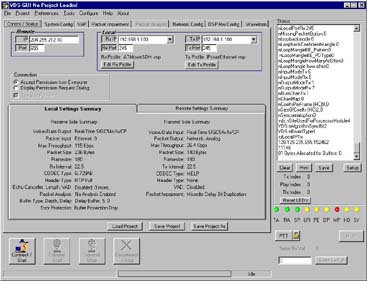
Example VDS user-interface display
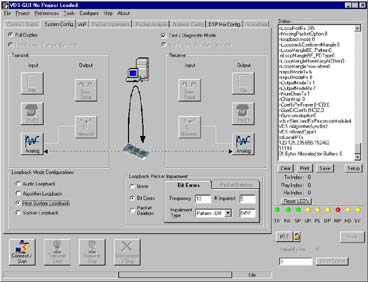
VDS full-duplex system configuration display example
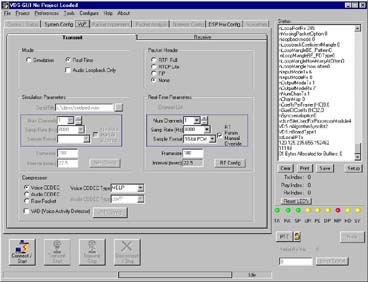
Example VoP options for transmit side configuration
|
VDS™ (Voice-over-packet Development System) software is an integrated environment that includes numerous development, analysis, measurement, test debug, and simulation functions for developing VoIP and VoATM systems.
The VDS environment combines both simulation and real-time operating modes. It includes support for several types of off-the-shelf DSP hardware, including Sig8304 cards and systems, SigC54xx and SigC55xx multiprocessor telecom modules, and Texas Instruments® DSK boards.
VDS test and measurement features include both packet analysis and packet impairment. Packets may deliberately be impaired with a variety of error types in order to debug and measure performance system components such as jitter buffer and echo canceller. The VDS environment and architecture supports operation as a fully automated test system.
Individual voice and audio processing components within VDS may be configured either as DSP software (DSP Mode, running on supported DSP hardware), or as host PC software components (Host Mode). Within the VDS user-interface, software components can be easily configured as DSP Mode or Host Mode in various combinations. This flexible and interactive configuration facilitates both development and analysis phases of VoIP and VoATM projects.
VDS includes network-side and telephony-side configuration and management. Voice software settings include CODEC type, echo canceller, jitter buffer, silence suppression, real-time parameters, and packet impairment test and measurement options. Voice software selections made from the GUI directly set properties in the Telogy voice software running in real-time on the C54xx DSP devices.
Packet impairment options include arbitrary delay, jitter, frame erasure, bit and burst errors, random, repeat, and pattern timing options. Voice/data I/O options include file, TDM, and analog.
Packet communication protocol support includes UDP/IP, RTP, RTCP, and TCP/IP (fax protocol).
Physical media configuration includes network (modem, DSL, LAN), and synchronous serial (RS-485, HDLC).
Hypersignal®-Macro and Hypersignal-Acoustic software series, which offer a number of simulation and real-time instrument functions. Simulation functions include DSP and math functions, time domain display (including waterfall, contour, magnitude, unwrapped phase), difference equation, digital FIR and IIR filter design, sampling rate conversion, frequency zoom, wavelet transform, minimum phase calculation, and many more. Instrument functions include spectrum analyzer, digital oscilloscope, stimulus & response measurement, continuous signal generation, real-time; "snap-in"; filtering, continuous disk record and generate, and more.
DirectDSP® is a Windows library that provides low-level and high-level calls for user-defined C/C++, Visual Basic, MATLAB®, or LabVIEW® programs. The DirectDSP API includes low-level hardware control functions such as reset/run/hold, register access, block memory transfer, DSP executable file download, etc. High-level functions include waveform file acquire/generate, continuous signal generation and execution of any arbitrary Hypersignal DSP or math function. DirectDSP includes strip-chart recorder, digital oscilloscope and digital tape recorder demo program and source code examples.
Using the DirectDSP software interface, C54xx processors do not need to be held or otherwise delayed when host software accesses onchip SRAM, and DSP source code does not need to be altered or "instrumented" in any way. The DirectDSP software interface to multiple DSPs is complimentary to JTAG debugging tools such as Code Composer Studio software, and may be used at the same time.
DirectDSP software provides Win9x and Linux driver support.
TheThe C54xx Source Code Interface contains numerous C54xx algorithms and functions in source and binary form, such as optimized FFTs, filters, matrix, transcendental, trig, signal manipulation function, processor and card initialization and analog I/O examples, etc. These functions form the basis of higher-level software functions and instruments; modification can be used to customize Hypersignal or DirectDSP software operation. User-defined C routine hooks are provided for real-time algorithm development. The C54xx Source Code Interface can be used as a basic foundation for user-defined real-time DSP systems and products.
|








